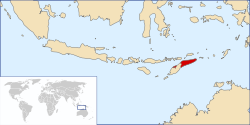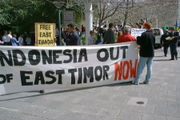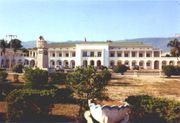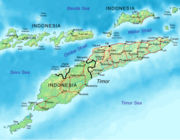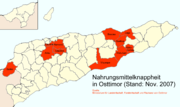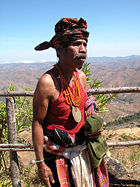East Timor
2008/9 Schools Wikipedia Selection. Related subjects: Asia; Asian Countries
| Repúblika Demokrátika Timór Lorosa'e República Democrática de Timor-Leste Democratic Republic of Timor-Leste
|
||||||
|---|---|---|---|---|---|---|
|
||||||
| Motto: Unidade, Acção, Progresso (Portuguese: "Unity, Action, Progress") |
||||||
| Anthem: Pátria |
||||||
|
|
||||||
| Capital (and largest city) |
Dili |
|||||
| Official languages | Tetum and Portuguese1 | |||||
| Demonym | East Timorese | |||||
| Government | Parliamentary republic | |||||
| - | President | José Ramos-Horta | ||||
| - | Prime Minister | Xanana Gusmão | ||||
| Independence | from Portugal² | |||||
| - | Declared | November 28, 1975 | ||||
| - | Recognized | May 20, 2002 | ||||
| Area | ||||||
| - | Total | 15,410 km² ( 158th) 5,743 sq mi |
||||
| - | Water (%) | negligible | ||||
| Population | ||||||
| - | July 2005 estimate | 1,115,000 ( 155th) | ||||
| - | Density | 64/km² ( 132nd) 166/sq mi |
||||
| GDP ( PPP) | 2005 estimate | |||||
| - | Total | $2.18 billion ( 206) | ||||
| - | Per capita | $800 ( 188) | ||||
| HDI (2007) | 0.514 (medium) ( 150th) | |||||
| Currency | U.S. Dollar³ ( USD) |
|||||
| Time zone | ( UTC+9) | |||||
| Internet TLD | .tl4 | |||||
| Calling code | +670 | |||||
| 1 | Indonesian and English are recognised by the Constitution as " working languages". | |||||
| 2 | Indonesia invaded East Timor on December 7, 1975 and left in 1999. | |||||
| 3 | Centavo coins also used. | |||||
| 4 | .tp is being phased out. | |||||
East Timor (officially the Democratic Republic of Timor-Leste) is a country in Southeast Asia. It comprises the eastern half of the island of Timor, the nearby islands of Atauro and Jaco, and Oecussi-Ambeno, an exclave on the northwestern side of the island, within Indonesian West Timor. The small country of 15,410 km² (5,400 sq mi) is located about 640 km (400 mi) northwest of Darwin, Australia.
East Timor was colonized by Portugal in the 16th century, and was known as Portuguese Timor until Portugal's decolonization of the country. In late 1975 East Timor declared its independence but was invaded and occupied by Indonesia later that year, and declared that country's 27th province the following year. In 1999, following the United Nations-sponsored act of self-determination, Indonesia relinquished control of the territory and East Timor became the first new sovereign state of the twenty-first century on May 20, 2002. East Timor is one of only two predominantly Roman Catholic countries in Southeast Asia, the other being the Philippines.
At US$800, the per capita GDP ( purchasing power parity adjusted) of East Timor is one of the lowest in the world. Its Human Development Index (HDI), however, corresponds to a medium degree of human development and places East Timor 142nd among the world's states.
Etymology and naming issues
"Timor" derives from timur, the word for "east" in Indonesian and Malay (hence the Indonesian Timor Timur) which became Timor in Portuguese and entered English as Portuguese Timor. Lorosa'e is also the word for "east" in Tetum, literally "rising sun".
The official names under the Constitution is República Democrática de Timor-Leste in Portuguese ( pron. IPA: [tiˈmoɾ ˈlɛʃtɨ]), which is almost universally used within the country, and in Tetum, Repúblika Demokrátika Timór Lorosa'e, which is infrequently used and is not standard across the many Tetum dialects. Following independence, the government requested the official name in all languages be Timor-Leste, but this has not been commonly adopted within English-speaking countries worldwide, where "East Timor" is the common usage. The Indonesian name Timor Timur, abbreviated as Timtim, is now less widely used, with the Indonesian government and media now using Timor Leste.
The official short form names of countries worldwide are set by the International Organisation for Standardization (ISO). The ISO 3166-1 official short name in English and all other languages is Timor-Leste. The ISO definition is adopted by the United Nations, the national standards organisations of France ( AFNOR), the United States of America ( ANSI), Britain ( BSI), Germany ( DIN) and Sweden ( SIS) and is universally used by international NGOs. Timor–Leste is used as a matter of protocol by the departments of foreign affairs of almost all countries for example, the USA Department of State and the European Union, notable exceptions being Australia, which uses "East Timor".
The ISO name gives rise to the standard three letter country code TLS and two letter country code TL as in the country’s internet domain name. The old two letter country code, TP, is gradually being phased out.
History
Early history
The island of Timor was originally populated as part of the human migrations that have shaped Australasia more generally. It is believed that descendants from at least three waves of migration still live in the country. The East Timorese are primarily of Melanesian races, with a population of 680,000 by the time of the Portuguese withdrawal in 1975. The first were related to the principal indigenous groups of New Guinea and Australia, and arrived before 40,000 years ago. Around 3000 BC, Austronesians migrated through to Timor, and are possibly associated with the development of agriculture on Timor. Thirdly, proto- Malays arrived from south China and north Indochina. The mountainous nature of the country meant that these groups remained separate, and explains why there is so much linguistic diversity in East Timor today.
Timor was incorporated into Chinese and Indian trading networks of the fourteenth century as an exporter of aromatic sandalwood, slaves, honey and wax. Early European explorers report that the island had a number of small chiefdoms or princedoms in the early sixteenth century. One of the most significant is the Wehale kingdom in central Timor, with its capital at Laran, West Timor, to which the Tetum, Bunaq and Kemak ethnic groups were aligned.
Portuguese colonization
The Portuguese were the first Europeans to colonize the Malay archipelago when they arrived in the sixteenth century. They established outposts in the (now Indonesian) Maluku Islands and Timor and surrounding islands. During the House of Habsburg's rule over Portugal (1580-1640), all surrounding outposts were lost and eventually came under Dutch control by the mid-seventeenth century. Effective European occupation of a small part of the territory only began after 1769, when the city of Dili, the capital of so-called Portuguese Timor, was founded. In the nineteenth century, the Netherlands gained a foothold on the western half of the island West Timor, and formally received it in 1859 through the Treaty of Lisbon. The definitive border was established by the Hague Treaty of 1916, and it remains the international boundary between the successor states East Timor and Indonesia.
For the Portuguese, East Timor remained little more than a neglected trading post until the late nineteenth century. Investment in infrastructure, health, and education was minimal. Sandalwood remained the main export crop with coffee exports becoming significant in the mid-nineteenth century. In places where Portuguese rule was asserted, it tended to be brutal and exploitative. At the beginning of the twentieth century, a faltering home economy prompted the Portuguese to extract greater wealth from its colonies which met Timorese resistance.
In late 1941, Portuguese Timor was briefly occupied by Dutch and Australian troops in an attempt to preempt a Japanese invasion of the island. The Portuguese Governor protested the occupation, and Dutch forces returned to the Dutch side of the island. The Japanese landed and drove the small Australian force out of Dili, and the mountainous interior became the scene of a guerrilla campaign, known as the Battle of Timor. Waged by Allied forces and Timorese volunteers against the Japanese, the struggle resulted in the deaths of between 40,000 and 70,000 Timorese. Following the end of the war, Portuguese control was reinstated.
The process of decolonization in Portuguese Timor began in 1974, following the change of government in Portugal in the wake of the Carnation Revolution. Owing to political instability and more pressing concerns over the decolonisation of Angola and Mozambique, Portugal effectively abandoned East Timor and it unilaterally declared itself independent on November 28, 1975. Nine days later, it was invaded and occupied by Indonesian forces before the declaration could be internationally recognized.
Indonesian occupation
As political parties began to form and emerge inside the country, the Indonesian military headed an operation that backed Apodeti, a pro-Indonesian party that encouraged divisions between the pro-independence parties of East Timor. This led to a brief civil war in 1975 as well as a series of attacks across borders. Indonesia alleged that the East Timorese FRETILIN party, which received some vocal support from the People's Republic of China, was communist. Fearing a Communist domino effect in Southeast Asia—and in the wake of its South Vietnam campaign—the United States, along with its ally Australia, supported the pro- Western Indonesian government's actions. The UN Security Council had a unanimous vote for Indonesia to stop its invasion and to withdraw immediately from East Timor’s borders, and was blocked by the United States from imposing any economic sanctions or other means of enforcing this mandate.
The territory was declared the twenty-seventh province of Indonesia in July 1976. Its nominal status in the UN remained that of a "non-self-governing territory under Portuguese administration."
Indonesian rule in East Timor was often marked by extreme violence and brutality; estimates of the number of East Timorese who died during the occupation vary from 60,000 to 200,000, A detailed statistical report prepared for the Commission for Reception, Truth and Reconciliation in East Timor cited a lower range of 102,800 conflict-related deaths in the period 1974-1999, namely, approximately 18,600 killings and 84,200 'excess' deaths from hunger and illness.
The East Timorese guerrilla force, Falintil, fought a campaign against the Indonesian forces from 1975 to 1999, some members being trained in Portugal by Portuguese special forces. The Dili Massacre proved a turning point for the East Timorese cause internationally, and a burgeoning East Timor solidarity movement grew in Portugal, Australia, and the United States.
Independence
Following a UN-sponsored agreement between Indonesia, Portugal and the United States and a surprise decision by the Indonesian President B. J. Habibie, a UN-supervised popular referendum was held on August 30, 1999 to choose between Special Autonomy within Indonesia and independence. 78.5% of voters chose independence, but violent clashes, instigated primarily by elements within the Indonesian military and aided by Timorese pro-Indonesia militias led by Eurico Guterres, broke out soon afterwards. A peacekeeping force ( INTERFET, led by Australia) intervened to restore order. The militias fled across the border into Indonesian West Timor, from which sporadic armed raids were attempted. As these raids were repelled and international moral opinion forced Indonesia to withdraw tacit support, the militias dispersed. INTERFET was replaced by a UN force of International Police, the mission became known as UNTAET, and the UNTAET Crime Scene Detachment was formed to investigate alleged atrocities. UNTAET was headed by the late Sérgio Vieira de Mello as UN Transitional Administrator from December 1999 to May 2002. On December 2, 1999 De Mello established the National Consultative Council (NCC), a political body consisting of 11 East Timorese and four UNTAET members charged with overseeing the decision-making process during the transition period leading to independence. However, UNTAET experienced difficulties initially in establishing its credibility amongst the Timorese leadership, leading to street violence. An important workshop on March 1, 2000 brought the Timorese and UN leadership group together to tease out a revised strategy, and identify institutional needs. The Timorese delegation was lead by José Ramos-Horta, and included Mari Alkatiri. The outcome was an agreed blueprint for a joint administration with executive powers, including leaders of the National Congress for Timorese Reconstruction (CNRT), led by future president Xanana Gusmão. Further details were worked out in a conference in May 2000. De Mello presented the new blueprint to a donor conference in Lisbon , on June 22, 2000, and to the UN Security Council on June 27, 2000 . On July 12, 2000, the NCC adopted a regulation establishing a Transitional Cabinet comprised of four East Timorese and four UNTAET representatives. . The revamped joint administration successfully laid the institutional foundations for independence, and on September 27, 2002, East Timor joined the United Nations.
Crisis and change
In April 2006, riots broke out in Dili following rivalry within the military and police; 40 people were killed and over 20,000 fled their homes. Fighting between pro-government troops and disaffected Falintil troops broke out in May 2006. Upon the invitation of the Prime Minister, Australia, Malaysia, New Zealand, and Portugal sent troops to Timor, attempting to quell the violence. On 26 June, Prime Minister Mari Alkatiri resigned as Prime Minister, following an ultimatum from President Xanana Gusmão that he would resign if Alkatiri did not. José Ramos-Horta was appointed as Alkatiri's successor on July 8, 2006. In April 2007, Gusmão declined another presidential term. In the build-up to the April 2007 presidential elections there were renewed outbreaks of violence in February and March 2007. José Ramos-Horta was inaugurated as President on May 20, 2007 following his election win in the second round. Gusmão was sworn in as Prime Minister on August 8, 2007. President Ramos-Horta was critically injured in an assassination attempt on February 11, 2008 in a failed coup apparently perpetrated by Alfredo Reinado, a renegade soldier who died in the attack. Prime Minister Gusmão also faced gunfire separately but escaped unharmed. The Australian government immediately sent reinforcements to East Timor to keep order.
Politics
The Head of state of the East Timor is the President of East Timor, who is elected by popular vote for a five-year term. Although the role is largely symbolic, the president does have veto power over certain types of legislation. Following elections, the president appoints the leader of the majority party or majority coalition as the Prime Minister of East Timor. As head of government, the prime minister presides over the Council of State or cabinet.
The unicameral Timorese parliament is the National Parliament or Parlamento Nacional, whose members are elected by popular vote to a five-year term. The number of seats can vary from a minimum of fifty-two to a maximum of sixty-five, though it exceptionally has eighty-eight members at present, due to this being its first term of office. The East Timorese constitution was modelled on that of Portugal. The country is still in the process of building its administration and governmental institutions.
Government departments
- Policia Nacional de Timor-Leste (police)
- East Timor Ministry for State and Internal Administration
- Civil Aviation Division of Timor Leste
- Immigration Department of Timor Leste http://www.migracao.gov.tl
Districts, subdistricts, and sucos
East Timor is divided into thirteen administrative districts:
1. Lautém 2. Baucau 3. Viqueque 4. Manatuto 5. Dili 6. Aileu 7. Manufahi 8. Liquiçá 9. Ermera 10. Ainaro 11. Bobonaro 12. Cova-Lima 13. Oecussi-Ambeno
The districts are subdivided into 65 subdistricts, 443 sucos and 2,336 towns, villages and hamlets.
Geography
Located in South East Asia, the island of Timor is part of the Malay archipelago, and is the largest and easternmost of the Lesser Sunda Islands. To the north of the mountainous island are the Ombai Strait and Wetar Strait, to the south the Timor Sea separates the island from Australia, while to the west lies the Indonesian Province of East Nusa Tenggara. The highest point of East Timor is Mount Ramelau (also known as Mount Tatamailau) at 2,963 meters (9,721 ft).
The local climate is tropical and generally hot and humid, characterised by distinct rainy and dry seasons. The capital, largest city and main port is Dili, and the second-largest city is the eastern town of Baucau.
The easternmost area of Timor-Leste consists of the Paitchau Range and Iralalaro area. This area has been proposed as to be the first conservation area in Timor-Leste as it contains the last remaining Tropical Dry forested area within the country as well as hosts a number of unique plant and animal species and is sparsely populated.
Economy
Prior to and during colonization, Timor was best known for its sandalwood.
In late 1999, about 70% of the economic infrastructure of East Timor was destroyed by Indonesian troops and anti-independence militias, and 260,000 people fled westward. From 2002 to 2005, an international program led by the United Nations, manned by civilian advisers, 5,000 peacekeepers (8,000 at peak) and 1,300 police officers, substantially reconstructed the infrastructure. By mid-2002, all but about 50,000 of the refugees had returned.
One promising long-term project is the joint development with Australia of petroleum and natural gas resources in the waters southeast of Timor. The Portuguese colonial administration granted concessions to Oceanic Exploration Corporation to develop the deposits, however, this was curtailed by the Indonesian invasion in 1976. The resources were divided between Indonesia and Australia with the Timor Gap Treaty in 1989. The treaty established guidelines for joint exploitation of seabed resources in the area of the "gap" left by then-Portuguese Timor in the maritime boundary agreed between the two countries in 1972. Revenues from the "joint" area were to be divided 50%-50%. Woodside Petroleum and ConocoPhillips began development of some resources in the Timor Gap on behalf of the two governments in 1992.
East Timor inherited no permanent maritime boundaries when it attained independence, repudiating the Timor Gap Treaty as illegal. A provisional agreement (the Timor Sea Treaty, signed when East Timor became independent on 20 May 2002) defined a Joint Petroleum Development Area (JPDA), and awarded 90% of revenues from existing projects in that area to East Timor and 10% to Australia. The first significant new development in the JPDA since Timorese independence is the largest petroleum resource in the Timor Sea, the Greater Sunrise gas field. Its exploitation was the subject of separate agreements in 2003 and 2005. Only 20% of the field lies within the JPDA and the rest in waters not subject to the treaty (though claimed by both countries). The initial, temporary agreement gave 82% of revenues to Australia and only 18% to East Timor.
The Government of East Timor has sought to negotiate a definite boundary with Australia at the halfway line between the countries, in accordance with the United Nations Convention on the Law of the Sea. The Government of Australia preferred to establish the boundary at the end of the wide Australian continental shelf, as agreed with Indonesia in 1972 and 1991. Normally a dispute such as this could be referred to the International Court of Justice or the International Tribunal for the Law of the Sea for an impartial decision, but the Australian government had withdrawn itself from these international jurisdictions (solely on matters relating to maritime boundaries) shortly before Timorese independence. Nevertheless, under public and diplomatic pressure, the Australian government offered instead a last-minute concession on Greater Sunrise gas field royalties alone. On July 7, 2005, an agreement was signed under which both countries would set aside the dispute over the maritime boundary, and East Timor would receive 50% of the revenues (estimated at A$26 billion or about US$20 billion over the lifetime of the project) from the Greater Sunrise development. Other developments within waters claimed by East Timor but outside the JPDA (Laminaria-Corallina and Buffalo) continue to be exploited unilaterally by Australia, however.
In 2007 bad harvest lead to a deaths in several parts of Timor-Leste. In November 2007 eleven subdistricts still needed food supply by international aid.
East Timor also has a large and potentially lucrative coffee industry, which sells organic coffee to numerous Fair Trade retailers and on the open market.
Currently three foreign banks have a branch in Dili: Australia's ANZ, Portugal's Banco Nacional Ultramarino, and Indonesia's Bank Mandiri.
There are no Patent Laws in East Timor.
Demographics
The population of East Timor is about one million. It has grown considerably recently, because of a high birth rate, but also because of the return of refugees. The population is especially concentrated in the area around Dili.
The Timorese are called Maubere collectively by some of their political organizations, an originally derogatory name turned into a name of pride by Fretilin. They consist of a number of distinct ethnic groups, most of whom are of mixed Malayo-Polynesian and Melanesian/ Papuan descent. The largest Malayo-Polynesian ethnic groups are the Tetum (or Tetun) (100,000), primarily in the north coast and around Dili; the Mambae (80,000), in the central mountains; the Tukudede (63,170), in the area around Maubara and Liquiçá; the Galoli (50,000), between the tribes of Mambae and Makasae; the Kemak (50,000) in north-central Timor island; and the Baikeno (20,000), in the area around Pante Macassar. The main tribes of predominantly Papuan origin include the Bunak (50,000), in the central interior of Timor island; the Fataluku (30,000), at the eastern tip of the island near Lospalos; and the Makasae, toward the eastern end of the island. In addition, like other former Portuguese colonies where interracial marriage was common, there is a smaller population of people of mixed Timorese and Portuguese origin, known in Portuguese as mestiços. The East Timorese mestiço best-known internationally is José Ramos-Horta, the spokesman for the resistance movement in exile, and now President of East Timor. Mário Viegas Carrascalão, Indonesia's appointed governor between 1987 and 1992, is also a mestiço. East Timor also has a small Chinese minority, most of whom are Hakka. Most left after the Indonesian invasion, with most moving to Australia although many Sino-Timorese have returned, including Pedro Lay, the Minister for Infrastructure.
Religion
Upon independence, East Timor became one of only two predominantly Roman Catholic countries in Asia (along with the Philippines). The population predominantly identifies as Roman Catholic (97%), though local animist traditions have a persistent and strong influence on the culture. Religious minorities include Muslims (1%) (including former Prime Minister Mari Alkatiri) and Protestants (1%) (including Taur Matan Ruak, Commander of the Falintil-FDTL). Smaller Hindu (0.5%), Buddhist (0.1%) and traditional animist minorities make up the remainder. Church membership grew considerably under Indonesian rule, as Indonesia's state ideology Pancasila does not recognize traditional beliefs and requires all citizens to believe in God. Although the struggle was not about religion, as a deep-rooted local institution the Church not only symbolized East Timor's distinction from predominantly Muslim Indonesia, but also played a significant role in the resistance movement, as personified by Bishop Carlos Filipe Ximenes Belo, the 1996 Nobel Peace Prize laureate. The constitution acknowledges the Church's role among the East Timorese people although it also stipulates a secular state that guarantees freedom of religion to everyone.
Languages
East Timor's two official languages are Portuguese, and Tetum, which belongs to the Austronesian family of languages spoken throughout South East Asia. The predominant form of Tetum, known as Tetun-Dili, grew out of the dialect favored by the colonizers at Dili, and thus has considerable Portuguese influence, but other dialects of Tetum are also widely used in the country, including Tetun-Terik which is spoken along the southwestern coast. Indonesian and English are defined as working languages under the Constitution in the Final and Transitional Provisions, without setting a final date. Another fifteen indigenous languages are spoken: Bekais, Bunak, Dawan, Fataluku, Galoli, Habun, Idalaka, Kawaimina, Kemak, Lovaia, Makalero, Makasai, Mambai, Tokodede, and Wetarese.
Under Indonesian rule, the use of Portuguese was banned, but it was used by the clandestine resistance, especially in communicating with the outside world. The language, along with Tetum, gained importance as a symbol of resistance and freedom and was adopted as one of the two official languages for this reason, and as a link to nations in other parts of the world. It is now being taught and promoted widely with the help of Brazil, Portugal, and the Latin Union, although its prominence in official and public spheres has been met with some hostility from younger Indonesian-educated Timorese.
According to the 2006 UN Development Report (using data from official census), under 5% of the Timorese population is proficient in Portuguese. However, the validity of this report has been questioned by members of the Timorese National Institute of Linguistics, which maintains that Portuguese is spoken by up to 25% of Timorese, with the number of speakers more than doubling in the last five years. Along with other local languages, Tetum remains the most common means of communication between ordinary Timorese, while Indonesian is still widely used in the media and school from high school to university. A large proportion of words in Tetum are derived from Portuguese, but it also shares many Malay-derived words with Indonesian. Many Indonesian words are still in common use in Tetum and other Timorese languages, particularly numbers.
East Timor is a member of the Community of Portuguese Language Countries (CPLP), also known as the Lusophone Commonwealth, and a member of the Latin Union. It is the only independent state in Asia with Portuguese as an official language, although this is also one of the official languages of China's Special Administrative Region of Macau.
Culture
The culture of East Timor reflects numerous influences, including Portuguese, Roman Catholic, and Malay, on the indigenous Austronesian and Melanesian cultures of Timor. Legend has it that a giant crocodile was transformed into the island of Timor, or Crocodile Island, as it is often called. East Timorese culture is heavily influenced by Austronesian legends, although the Catholic influence is also strong.
Illiteracy is still widespread, but there is a strong tradition of poetry. Prime Minister Xanana Gusmão, for example, is a distinguished poet. As for architecture, some Portuguese-style buildings can be found, along with the traditional totem houses of the eastern region. These are known as uma lulik (sacred houses) in Tetum, and lee teinu (houses with legs) in Fataluku. Craftsmanship is also widespread, as is the weaving of traditional scarves or tais.
Sports
International sports associations
East Timor has joined many international sport associations, including the International Olympic Committee (IOC). The IOC board has granted full recognition to the East Timorese Olympic Committee (COTL). The IOC had allowed a mainly symbolic four-member team to take part in the 2000 Sydney Games under the Olympic flag as "Independent Olympic Athletes." The Federação de Timor-Leste de Atletismo has joined the International Association of Athletics Federations (IAAF). The Federação de Badminton de Timor-Leste joined the International Badminton Federation (IBF) in April 2003. The East Timor Cycling Federation has joined the Union Cycliste Internationale. The Confederação do Desporto de Timor Leste has joined the International Weightlifting Federation. East Timor is also a full member of the International Table-Tennis Federation (ITTF). In September 2005, East Timor's national football team joined FIFA.
Participation in international events
East Timor has taken part in several sporting events. Although the athletes came back with no medals, East Timorese athletes had the opportunity to compete with other Southeast Asian athletes in the 2003 Southeast Asian Games held in Vietnam in 2003. Most of their equipment was lent by the other nations competing. In the 2003 ASEAN Paralympics Games, also held in Vietnam, East Timor won a bronze medal. In the Athens 2004 Olympic Games, six athletes participated in three sports: athletics, weightlifting and boxing).
On East Timor's performance in the 22nd SEA Games in 2003, karate coach Austo Aparício remarked, "This was an opportunity for our athletes to gain experience. East Timor is still young, so it has lots of financial problems." He also commented on his team's karate performance, "We are fairly good at karate and we can make sure that we win a medal in the Philippines in 2005." East Timor went on to win three medals in Arnis at the 2005 Southeast Asian Games.
East Timor was also one of the competing nations in the first Lusophony Games, winning a bronze medal in the women's volleyball competition (finishing third out of three teams), despite the fact the team had lost all its three games.
Public holidays
East Timor now has public holidays that commemorate historic events in the liberation struggle, as well as those associated with Catholicism and Islam. They are defined in Timor-Leste Law no. 10/2005 PDF (16.7 KiB).
| Date | Name | Notes |
|---|---|---|
| January 1 | New Year's Day | |
| date varies | Eid al-Adha | |
| March-April | Good Friday | |
| May 1 | Labour Day | |
| May 20 | Independence Restoration Day | Anniversary of transfer of sovereignty from the United Nations transitional government, 2002 |
| May-June | Corpus Christi | |
| August 30 | Popular Consultation Day | Anniversary of the Popular Consultation, 1999 |
| November 1 | All Saints' Day | |
| November 2 | All Souls' Day | |
| November 12 | National Youth Day | Anniversary of the Santa Cruz massacre, 1991 |
| November 28 | Proclamation of Independence Day | 1975 |
| date varies | Idul Fitri | |
| December 7 | National Heroes' Day | Anniversary of Indonesian invasion of East Timor, 1975 |
| December 8 | Immaculate Conception | |
| December 25 | Christmas Day |
In addition, the law defines "official commemorative dates" which are not considered holidays but could be subject to time off from work:
| Date | Name |
|---|---|
| February-March | Ash Wednesday |
| March-April | Holy Thursday |
| May-June | Ascension Day |
| June 1 | International Children's Day |
| August 20 | Day of the Armed Forces for the National Liberation of Timor-Leste (FALINTIL) |
| November 3 | National Women's Day |
| December 10 | International Human Rights Day |


